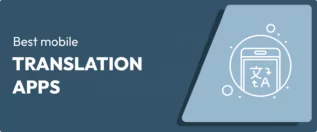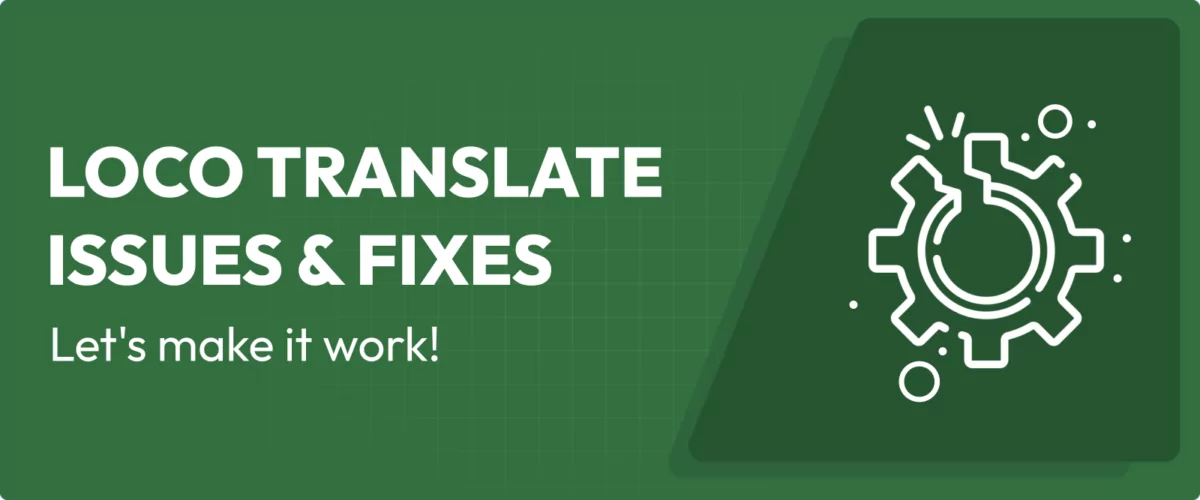
In this post
Having issues with Loco Translate not working?
Most of the time, Loco Translate offers an easy way to let you translate strings in the core WordPress software, as well as your themes and plugins. You can use this ability to localize your site in whatever single language you want to use.
However, sometimes you’ll run into issues with Loco Translate not translating some or all of the content in some or all of your site’s extensions. Or, you might experience other problems, such as errors when saving, missing translation files, and so on.
If that’s happening to you, this post is here to help.
Below, we’ll start off by explaining the most common causes of Loco Translate not working, along with how to fix those issues.
If those troubleshooting steps aren’t able to fix your problem, we’ll also share a Loco Translate alternative that gives you another way to translate your site’s content (or even create a multilingual website, if that’s your goal).
Loco Translate Not Working: Common Issues and Fixes
Without further introduction, let’s get straight into our tips for fixing issues with Loco Translate not working.
In addition to some general tips to try before you go any further, we’ll cover fixes for seven types of problems:
- Loco Translate is missing some strings in a theme or plugin (but is otherwise working correctly)
- Loco Translate translations aren’t showing up on your site
- Translation files keep disappearing
- Errors when saving or syncing files (e.g. 404 Not Found or other 400-level errors)
- 413 Request Entity Too Large error when saving files
- Allowed memory size exhausted error (especially when syncing files)
- Not being able to translate dynamic content
Try These Things Before Troubleshooting
Before you get any further into troubleshooting issues with Loco Translate not translating, you’ll first want to perform some housekeeping steps to eliminate some basic issues.
Update to the Latest Version of Everything
First, make sure that you’re using the latest version of everything that’s involved in translating your site. That includes the Loco Translate plugin itself, as well as the core WordPress software and the themes/plugins that you’re translating.
Set Your WordPress Site Language
Next, make sure that you’ve properly set your WordPress site’s language to the correct language that you want to use on your site:
- Go to Settings → General in your WordPress dashboard.
- Set the Site Language equal to the language that you want to use.
- Click the Save Changes button at the bottom.
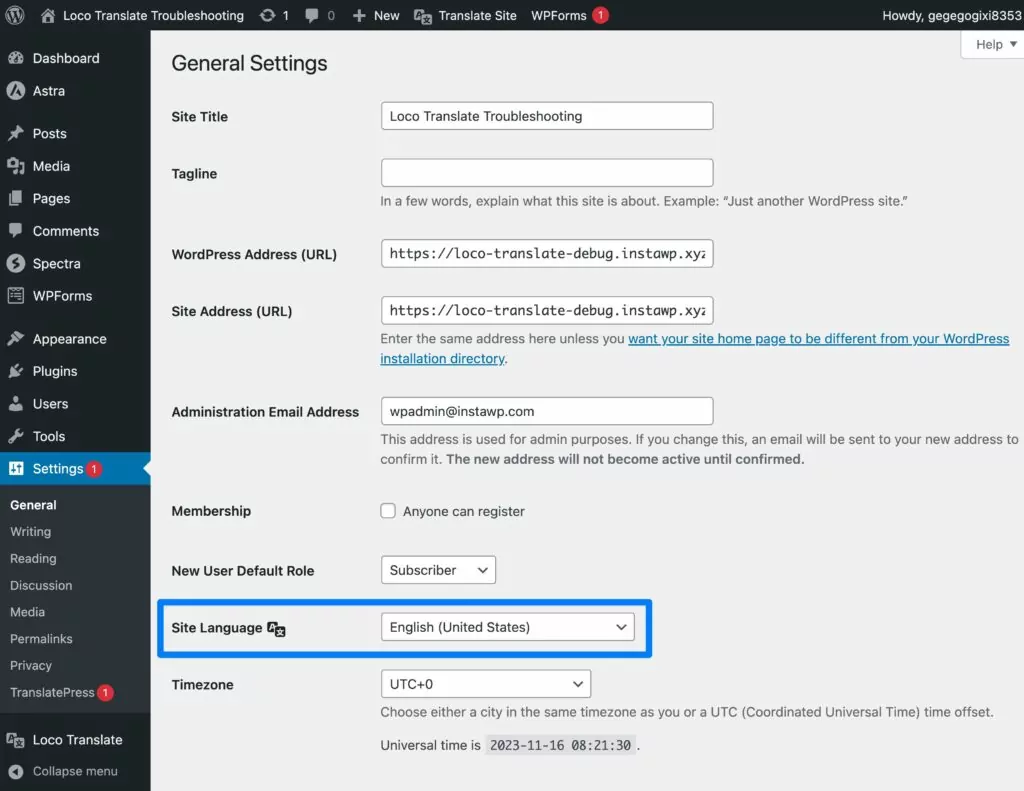
Clear Your Caches
Finally, make sure to clear all of the caches on your site.
Caching is a great way to improve performance by storing files in a static cache instead of downloading them/generating them dynamically. However, if something is wrong in the cached file, that can cause all kinds of weird issues.
For this reason, a good first troubleshooting step with any WordPress issue is always to clear your cache.
Here’s how:
- Clear the browser cache in the web browser that you’re using to access your site. Kinsta has a guide that shows you how to clear the browser cache in all popular browsers.
- Clear your site’s page cache. You can do this via your host if your host offers server-level caching or via your caching plugin.
- Clear the CDN cache if you’re using a CDN service.
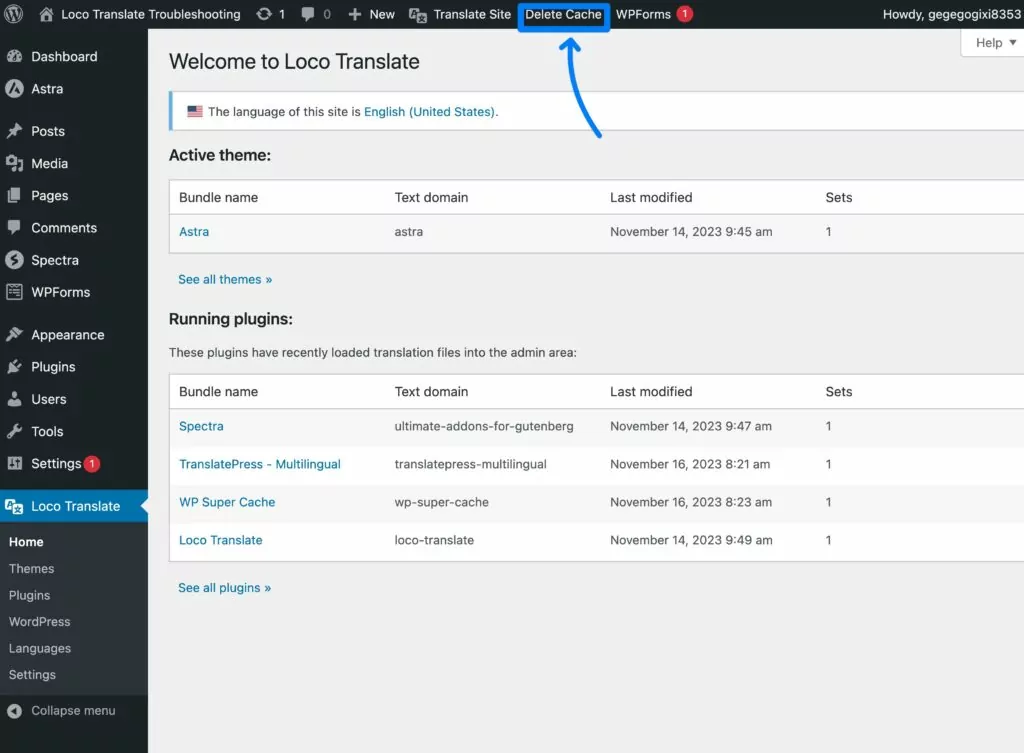
Once you’ve performed these basic troubleshooting steps, you can move on to the Loco Translate-specific steps if Loco Translate is still not translating content.
Loco Translate Translations Aren’t Showing Up
In some situations, you might be able to translate everything in the backend of Loco Translate. However, those translations might not actually show up on the frontend of your site.
Obviously, that’s frustrating, so let’s go through some potential problems and fixes.
Your Translation Files Might Have Been Deleted
Depending on how you save your translation files, they might get deleted when you apply an update, which will lead to Loco Translate not translating content on the frontend of your site.
We cover how to fix this problem in a dedicated section below. But the basic idea is that you should try to save your translation files in a special folder that Loco Translate creates on your server. This will protect them from being overwritten when you apply updates.
You can move your translation file to a new folder from the Relocate tab. We recommend trying the Custom option and seeing if that fixes the problem.
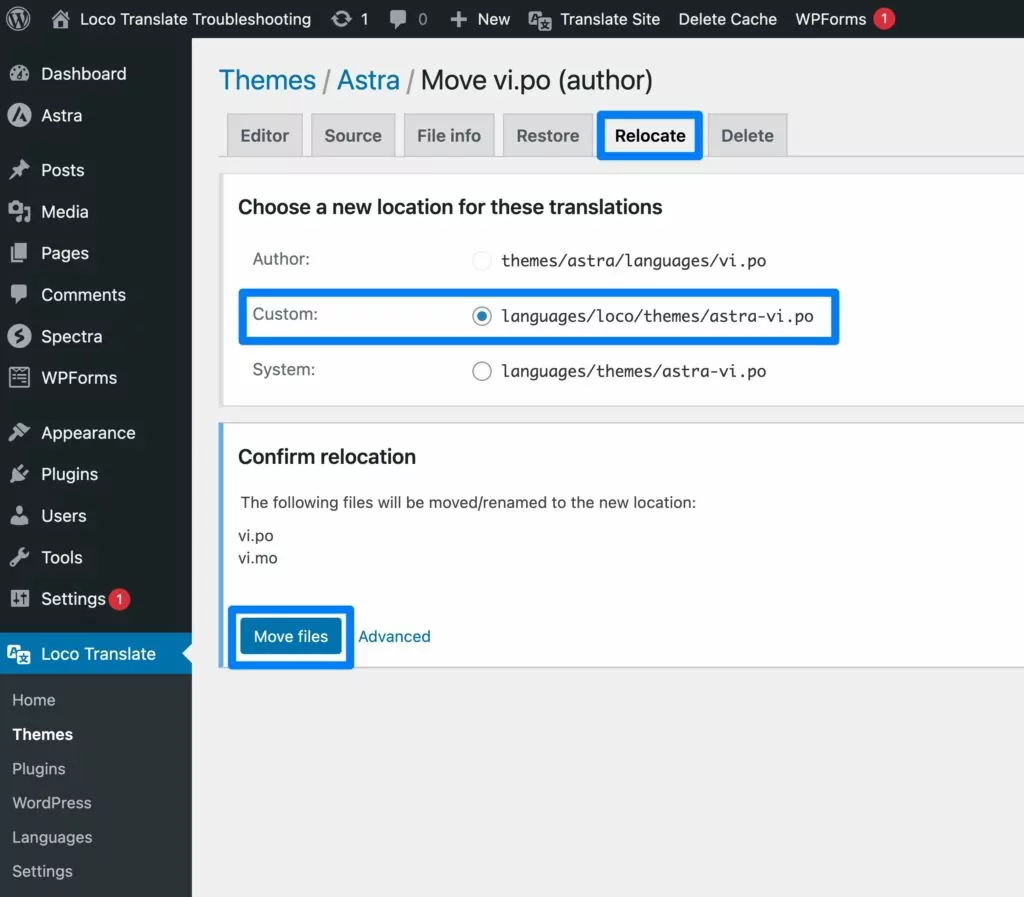
Your WordPress Site Language Is Wrong
We already covered this in the “Try These Things Before Troubleshooting” section above. But if your WordPress language isn’t set properly, that will mean your translations don’t load.
For example, if your translations are in Spanish but your site language is still set to English, WordPress will display everything in English rather than using your translations.

Your Translation Files Aren’t Being Loaded
You also might have issues if your translation files exist, but aren’t being loaded.
Unfortunately, you’ll need to feel comfortable analyzing code to implement many of these troubleshooting steps. Additionally, you’ll often need to enlist the help of the plugin or theme’s developer to actually fix the problem for good.
There are a few reasons why themes and plugins might not load your translation files:
- The extension isn’t calling the load_textdomain function (load_theme_textdomain for themes and load_plugin_textdomain for plugins). You’ll need to ask the extension’s developer to fix this problem to ensure your translations load correctly.
- Your translation files aren’t named correctly. This can happen if the extension is coded incorrectly and declaring a different text domain than the one it actually uses. Again, you’ll need to contact the extension’s developer to have them fix this.
- The extension’s translation template is out of date. If the translation template doesn’t match the source code, this could mean that the strings that you thought you translated don’t actually exist in the source code. Again, you’ll need to ask the developer to update the translation template.
Loco Translate Is Missing Some Strings in a Theme or Plugin
In some cases, you might run into a situation where Loco Translate mostly works, but it’s not recognizing certain strings in the theme or plugin that you want to translate.
This could lead to an awkward situation where you have incomplete translations, with some content being properly translated while the remaining content is still in the original language.
The most common issue here is the way in which the theme or plugin is coded. For example, if the plugin is dynamically storing the relevant string in your site’s database as a WordPress site option, you might not be able to access it in Loco Translate.
However, there are also some other potential issues, so it’s worth digging a little deeper into this problem.
Make Sure You Know Where the String Is Coming From
The first troubleshooting step is to make sure that you actually know where the string is coming from.
For example, if you think the string is coming from the core WordPress software but it’s actually coming from a plugin, that might explain why you’re unable to find it.
You might also have situations where the same string is located in two different spots. You might’ve translated one source of that string, but missed the other source.
Run a Sync If the String Is Completely Missing
Once you know exactly where the string should be, you can start debugging things in more depth.
If you cannot find the string at all, you should try syncing translations again. You can do this by clicking the Sync button in the editor:
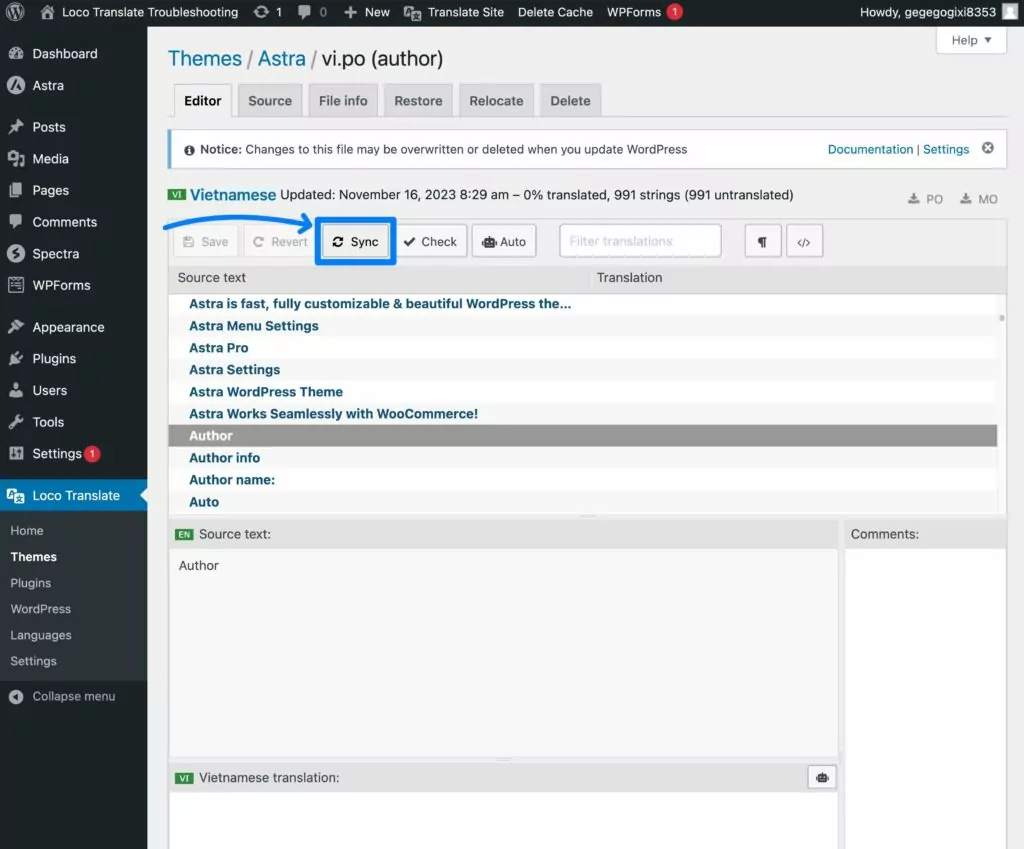
This can often fix the problem, but it’s not foolproof.
For example, if the extension developer hasn’t provided a valid translation template, Loco Translate will need to try to extract the strings from the source code, which might not work in certain situations (it largely depends on how the developer has coded things and whether they followed best practices).
You can create your own translation template to fix the problem. However, you’ll need development knowledge to do so, so this isn’t a fix for casual users. Your best bet would be to reach out to the developer behind the extension to ask them for help.
Loco Translate Translation Files Keep Disappearing
If you’re running into issues with your Loco Translate translation files disappearing, the most common issues are automatic WordPress updates and the location where you’ve saved your translation files.
If you’re saving your translation files in the plugin or theme folder of the content that you’re translating, those translation files will usually be overwritten whenever you update the relevant theme or plugin.
This can also happen with core translations when WordPress updates the installed languages on your site.
If you have automatic updates enabled for themes and plugins, this could happen automatically even without you manually updating the extension.
To fix this, you should make sure to save your translation files in the “safe” directory that Loco Translate provides. This is located in the following folder:
wp-content/languages/loco
You can choose this by selecting the Custom option when you’re creating/moving a file.
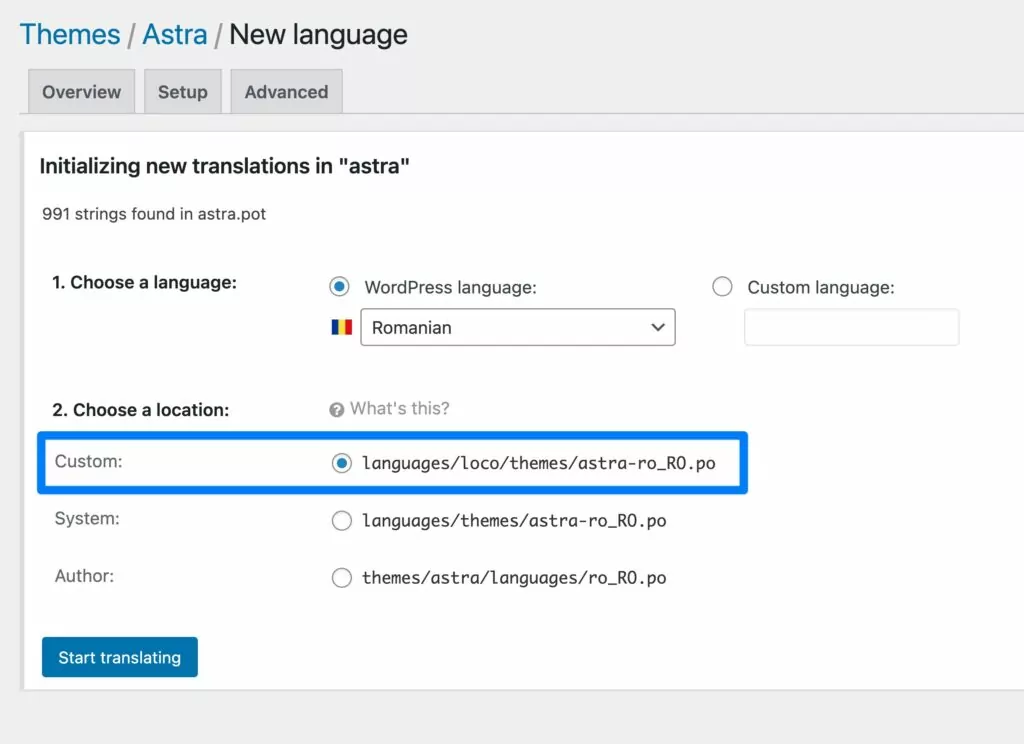
By saving translation files in this folder, you can be confident that they won’t be overwritten during WordPress updates.
For core translation files, you can also disable automatic translation file updates by adding the following filter to your site’s wp-config.php file:
add_filter( 'auto_update_translation', '__return_false' );
400-Level HTTP Errors When Saving Loco Translate (404 Not Found, 403 Forbidden, 410 Gone, etc.)
If you’re experiencing 400-level HTTP errors when trying to save Loco Translate, the most common problem is an issue in your server’s configuration.
Common error codes here include the following:
- 404 Not Found
- 403 Forbidden
- 410 Gone
These can be trickier to fix because it involves how your server is configured. As a result, you might need some technical knowledge to debug these issues.
Here are some tips for areas to consider:
- Check Gzip compression configuration – some server compression modules (e.g. mod_deflate) can cause issues. You can try disabling Gzip compression when making requests to wp-admin/admin-ajax.php.
- Try disabling PHP’s zlib.output_compression setting.
- Try temporarily disabling your site’s firewall – you could be experiencing issues because of a security plugin like Wordfence or a server module like mod_security. You should not leave the firewall permanently disabled, though, so you’ll need to find a more long-term solution if this is causing the problem.
If all else fails, consider reaching out to your hosting service, as they might be able to adjust the server configuration to stop the issue from happening.
413 Request Entity Too Large When Saving Files in Loco Translate
Another issue you might run into when saving files is the 413 Request Entity Too Large error.
This error happens when the PO file that you’re trying to save is larger than what your server is configured to accept via POST data.
If your server’s configuration is below the size of the PO file (which can happen for large plugins like WooCommerce), you’ll need to raise the limit to fix the problem.
To check your server’s current limit, you can go to Loco Translate → Settings → Debug in your WordPress dashboard and look at the PHP post_max_size limit.
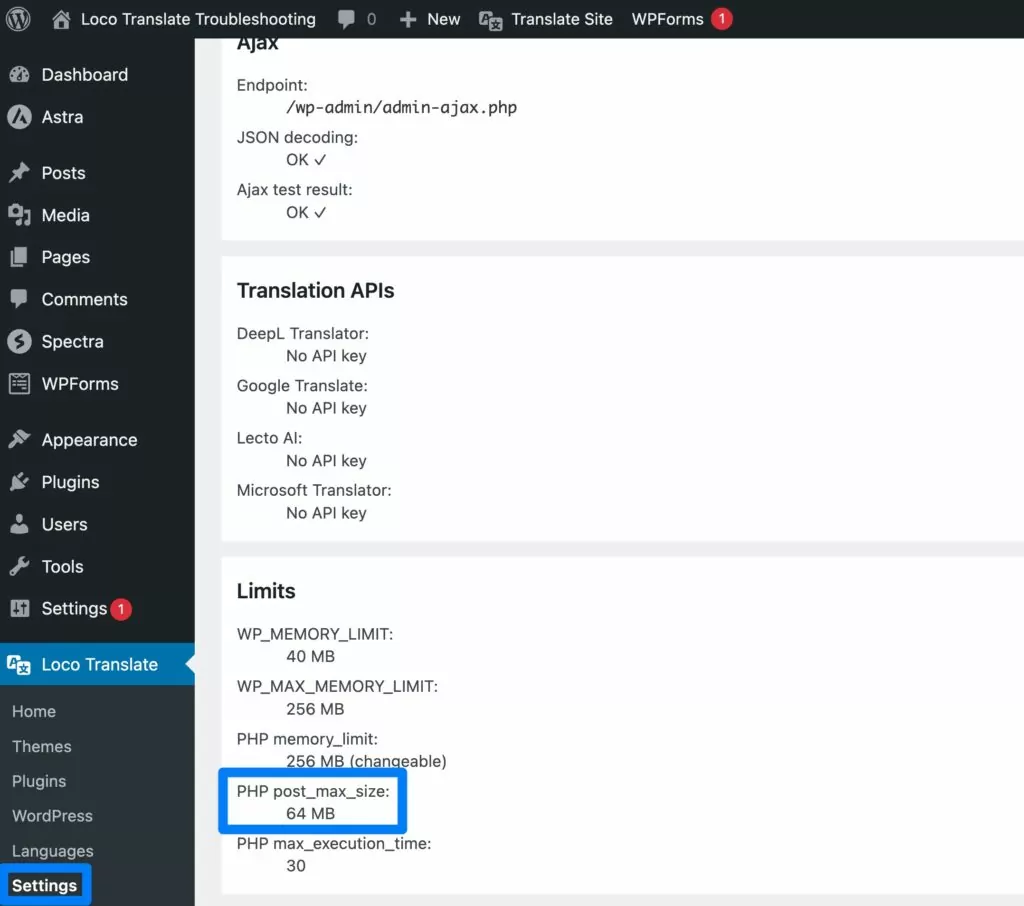
To increase these limits, you’ll need to edit your server’s configuration, focusing on these limits:
- the PHP post_max_size limit (not the upload_max_filesize limit, which is what many users focus on)
- If using Apache, the LimitRequestBody limit
- If using Nginx, the client_max_body_size limit
If you don’t feel comfortable editing these server-level configuration files, we recommend reaching out to your host’s support for help.
Allowed Memory Size Exhausted When Syncing in Loco Translate
When you first extract text strings from a file, Loco Translate can have high memory usage during those operations, especially for larger translation files where the developer hasn’t provided a translation template.
This can lead to a memory usage spike that triggers the “Error: Allowed memory size exhausted” message.
If possible, you can try to raise the memory limit of your site/server:
- Increase the PHP memory limit
- Increase the WP_MEMORY_LIMIT variable in your site’s wp-config.php file
You can check your site’s current limits by going to Loco Translate → Settings → Debug.
If you don’t feel comfortable making these changes yourself, you can reach out to your host’s support for help.
If increasing the memory limit isn’t possible, Loco Translate lets you skip files over a certain maximum size. By default, it skips files larger than 100K, but you can adjust this by going Loco Translate → Settings and adjusting the number.
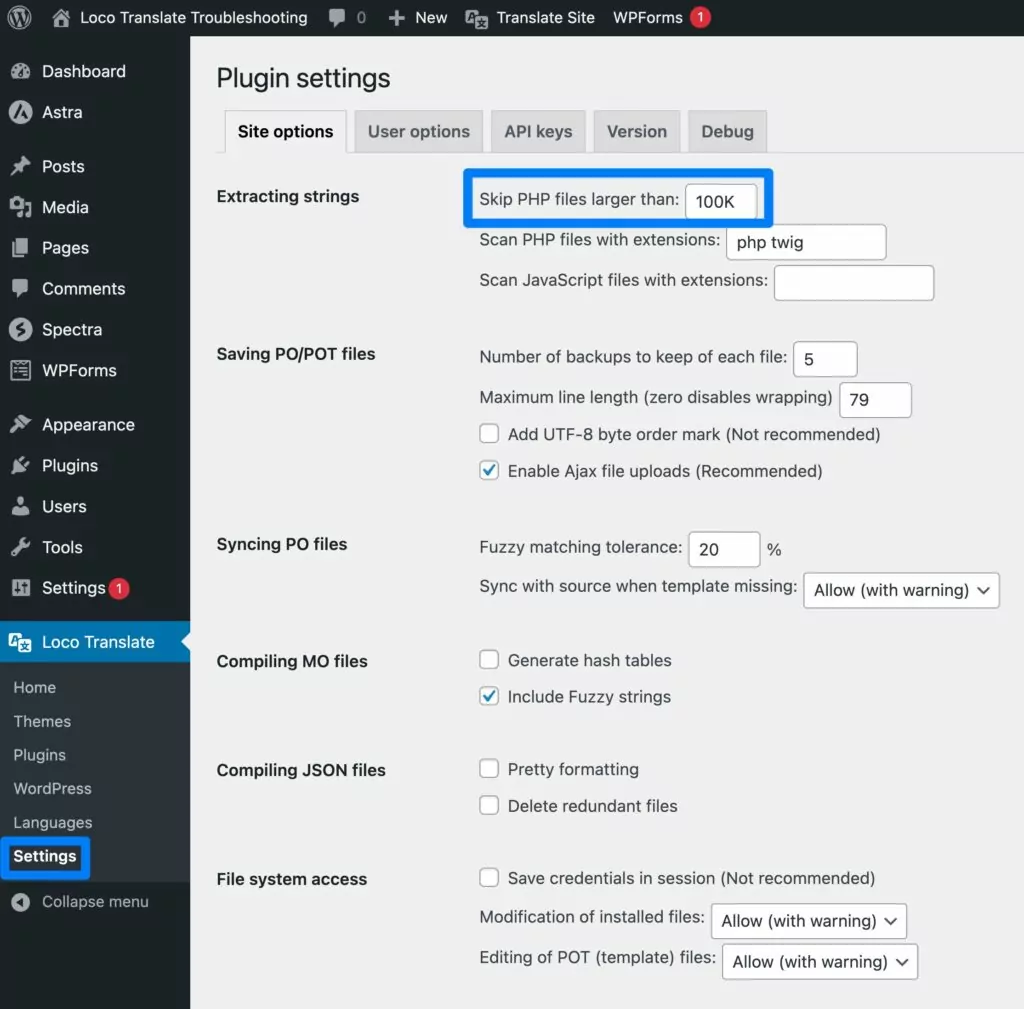
Loco Translate Doesn’t Let You Translate Dynamic Content (E.g. Content in the WordPress Editor)
This last one isn’t really an instance of Loco Translate not working – it’s just outside the scope of what Loco Translate offers.
Loco Translate makes it easy for you to access and translate the translation files in the WordPress core, plugins, and themes.
However, it does not help you translate content that you’ve added in the WordPress editor or other dynamic areas.
For a single language site, this isn’t a problem because you can just add that content in your target language.
But if you want to create a multilanguage site where users can choose between two or more languages for each piece of content, Loco Translate probably isn’t the right plugin for the job.
That brings us to the next part of our article – a Loco Translate alternative that you can consider if you’re still experiencing issues with Loco Translate and/or you want to actually create a multilingual WordPress site.
TranslatePress: An Alternative to Consider If Loco Translate Isn’t Working
If you’re still having issues on WordPress with Loco Translate not working, you can consider TranslatePress.
TranslatePress offers an easy way to translate all of your site’s content using a visual, point-and-click editor. It offers a comprehensive approach, with full support for content from the WordPress core, as well as any plugins and themes that you’re using.

Here’s a more detailed look at why TranslatePress can make a great Loco Translate alternative…
TranslatePress Multilingual
Comprehensive Translations, Even If a Plugin Is Coded Differently
One of the advantages of TranslatePress is that it’s able to offer comprehensive translation support for all the content on your site, including plugins and themes.
While Loco Translate generally does a good job of detecting strings in the plugins and themes that you’re translating, you might run into certain situations in which Loco Translate isn’t able to detect certain strings, which can leave you with incomplete translations.
This typically happens because of how the theme/plugin developer has coded their extension, rather than an issue with Loco Translate itself. But the end result is the same – you struggle to fully translate your site.
TranslatePress is able to bypass this issue by using a different method of detecting translations. Rather than looking at the behind-the-scenes code in a certain theme or plugin, TranslatePress instead looks at the frontend output of your site.
If a certain string appears on your site, TranslatePress will let you translate it regardless of how it appears in the behind-the-scenes code. It also still offers special handling for WordPress gettext content.
Overall, if you’ve been frustrated by incomplete translations or the difficulty in translating certain strings on your site, TranslatePress can be a good alternative to consider.
Visual, Point-and-Click Translation Editor
Whereas Loco Translate has you work using an interface that resembles a traditional PO editor, TranslatePress lets you manage translations using a visual, point-and-click editor.
You’ll see a live preview of your page on the right and a sidebar on the left.
To open a string for translation, all you need to do is hover over it and click on the pencil icon. The pencil icon will be green for gettext strings and blue for dynamic strings.

Full Multilingual Support
Loco Translate is primarily just a tool for accessing an easier way to manage translations. Instead of needing to work with .po or .mo files directly, it gives you an in-browser interface to access translations.
While this is great if you just need to translate a plugin or theme into a single language, it’s not so helpful if you want to actually create a multilingual website where your site’s visitors can use a frontend language switcher to choose between two or more different languages.
While you can use TranslatePress on a single-language site, its primary focus is helping you create a working multilingual website.
Affordable Pricing (Plus a Free Version)
Like Loco Translate, TranslatePress offers a free version that’s available at WordPress.org, as well as a premium version that adds more functionality.
The free version already gives you access to the visual translation editor, as well as the ability to translate all of the frontend content from the core WordPress software and your themes/plugins.
If you want access to even more functionality, the premium version adds support for unlimited languages (great for multilingual sites with 3+ languages), dedicated translator accounts, multilingual SEO features, and more, starting at just €89.
When in doubt, you can always start with the free version and upgrade later on. All of your translations and settings will still be there even if you move from the free version to the premium version.
How to Get Started With TranslatePress
If you want to try TranslatePress as a Loco Translate alternative, here’s a very quick guide on how you can get started:
- Install the free TranslatePress plugin from WordPress.org (or purchase and install the premium version).
- Go to Settings → TranslatePress to choose which languages you want to offer on your site.
- Optional – Go to the Automatic Translation tab in the TranslatePress settings area to set up machine translation via Translate AI or Google Translate or DeepL APIs.
- Open a page with content that you want to translate on the frontend of your site – this could be content from the core software, a theme, a plugin, and so on. As long as the content is visible somewhere on that page, you’ll be able to translate it.
- Click the new Translate Page option on the WordPress toolbar to launch the visual translation editor.
- On the live preview of your site, hover over the piece of content that you want to translate and click the pencil icon.
- Add your translation in the sidebar and save your changes.
- Repeat to translate additional content as needed.
To view full tutorials that cover all of these in a lot more depth, you can check out these posts:
- How to create a multilingual WordPress site
- The ultimate guide to creating a multilingual website
- How to offer WordPress in multiple languages
Loco Translate Not Working? Now You Can Fix It
Loco Translate is a great tool for helping you translate content on WordPress. However, things can quickly turn frustrating if you run into a situation where Loco Translate isn’t working properly.
In this post, you learned a number of troubleshooting tips to figure out what’s going wrong and fix Loco Translate not working.
If you’re still running into problems after trying these fixes, you also might want to consider TranslatePress as a Loco Translate alternative.
If you want to try TranslatePress and see if it meets your needs for your current situation, you can install the free version from WordPress.org to already access the ability to comprehensively translate your site.
Then, you can always upgrade to the premium version of TranslatePress to access additional functionality without losing any of your existing translations.


